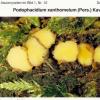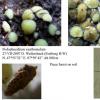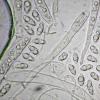
15-12-2025 15:48
 Danny Newman
Danny Newman
Melanospora cf. lagenaria on old, rotting, fallen

15-12-2025 15:54
 Johan Boonefaes
Johan Boonefaes
Unknown anamorph found on the ground in coastal sa

15-12-2025 21:11
 Hardware Tony
Hardware Tony
Small clavate hairs, negative croziers and IKI bb

15-12-2025 07:09
 Danny Newman
Danny Newman
indet. Rutstroemiaceae sp. on unk. fallen leavesMc

15-12-2025 07:05
 Danny Newman
Danny Newman
Pseudosclerococcum golindoi (det: Zotto)near Cosb

15-12-2025 11:49
 Danny Newman
Danny Newman
ITS sequences from the following two collections B

15-12-2025 12:34
 Danny Newman
Danny Newman
indet. Rhytismataceae on oak leafnear Purchase Roa

09-12-2025 12:06
 Andgelo Mombert
Andgelo Mombert
Bonjour,Je recherche l'article concernant Hypobryo
Podophacidium?
Renée Lebeuf,
27-09-2010 00:18
J'ai fait la récolte hier d'une minuscule espèce qui me semble posséder les caractéristiques d'un Podophacidium, mais dont la couleur ne semble pas correspondre aux deux espèces décrites.
Apothécie jusqu'à 2,5 mm, turbinée, sessile, recouverte d'une couche orangée granuleuse sur toute sa surface s'ouvrant pour former une étoile.
Spores 11-17 x 5-6, lisses, munies de 2 ou 3 grosses guttules et parfois de plus petites.
Asques inoperculées, munies de crochets, 120-135 x 10-12 µm, à pore apical bleu dans le Lugol.
Paraphyses, en crosse ou droites, parfois ramifiées à l'apex, 2-3 µm de largeur.
Pourriez-vous me dire ce que vous en pensez ou m'orienter vers un autre genre si je fais fausse route.
Merci d'avance.
Renée Lebeuf
Montréal, Québec
Hans-Otto Baral,
27-09-2010 15:40

Re:Podophacidium?
Dear Renée
Clearly this is Podophacidium, and I feel your marcro is not far from photos in Breitenbach or Schmid (the latter here attached), or my old drawing on the DVD. I am unaware of more than 1 species in that genus. I only wonder why Breitenbach and Schmid figure medium-sized LBs in the spores which I otherwise see as very big drops as wide as the spore.
Zotto
Clearly this is Podophacidium, and I feel your marcro is not far from photos in Breitenbach or Schmid (the latter here attached), or my old drawing on the DVD. I am unaware of more than 1 species in that genus. I only wonder why Breitenbach and Schmid figure medium-sized LBs in the spores which I otherwise see as very big drops as wide as the spore.
Zotto
Renée Lebeuf,
28-09-2010 00:39
Re:Podophacidium?
Dear Zotto. In the description of Seaver in North American Cup Fungi, it is said that the envelope is black, and not orange as in my specimens and your photo. It is why I thought it might be another species. I already found specimens with the black envelope (I include here a picture). So you think that orange colour could fit into the description of the species?
Renée
Renée
Hans-Otto Baral,
28-09-2010 08:50

Re:Podophacidium?
I actually noticed this colour difference from the plate by J. Labrecque and R. Labbé. As you have both forms you can compare the microscopy if there is any difference. By the way, also Boudier figures yellow apos with a brown margin, see here.
The only further species in IF is P. pulvinatum Raitv. & Järv 1997: on fallen leaves, but that differs in much narrower spores (17-20 x 2-3 µm) and apos without teeth. I have a drawing of what might also be a Podophacidium, on pine wood, with spores 13-17 x 3-3.3 µm, apos reddish-brown, with prominent teeth (HB 6955, on DVD as Phacidium).
Zotto
The only further species in IF is P. pulvinatum Raitv. & Järv 1997: on fallen leaves, but that differs in much narrower spores (17-20 x 2-3 µm) and apos without teeth. I have a drawing of what might also be a Podophacidium, on pine wood, with spores 13-17 x 3-3.3 µm, apos reddish-brown, with prominent teeth (HB 6955, on DVD as Phacidium).
Zotto
Renée Lebeuf,
28-09-2010 16:20
Re:Podophacidium?
In my notes on the first collection (black form), I have:
Ascus 100-140 x 9, with croziers
Spores 10.5-11.5 x 4.5-5, multiguttulate
Paraphyses 1.5 µm wide and of the same form as the orange form
All the elements are similar in shape, but the size of the spores appears smaller than in the orange form.
In Breitenback and Kranzlin, the envelope is also black. The measures in that book fit with my own measures of the black form.
This is very interesting!
Renée
Ascus 100-140 x 9, with croziers
Spores 10.5-11.5 x 4.5-5, multiguttulate
Paraphyses 1.5 µm wide and of the same form as the orange form
All the elements are similar in shape, but the size of the spores appears smaller than in the orange form.
In Breitenback and Kranzlin, the envelope is also black. The measures in that book fit with my own measures of the black form.
This is very interesting!
Renée
Hans-Otto Baral,
28-09-2010 17:40
Hans-Otto Baral,
28-09-2010 17:41
Hans-Otto Baral,
28-09-2010 19:27

Re:Podophacidium?
thanks, that looks very good :-)
Zotto
Zotto
Thomas Læssøe,
27-10-2010 12:13
Re:Podophacidium?
Dear Renée
We at Mycokey.com would dearly love to use your images of this beautiful fungus. If you accept please send to Jens.h.petersen@biology.au.dk :)
We at Mycokey.com would dearly love to use your images of this beautiful fungus. If you accept please send to Jens.h.petersen@biology.au.dk :)
Renée Lebeuf,
04-12-2010 22:52
Re:Podophacidium?
Dear Thomas,
I wrote to Jens Petersen more than a month ago but never got an answer back. I would agree to provide you some pictures.
I wrote to Jens Petersen more than a month ago but never got an answer back. I would agree to provide you some pictures.








